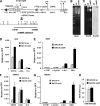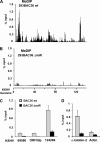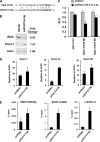Epigenetic regulation of Kaposi's sarcoma-associated herpesvirus latency by virus-encoded microRNAs that target Rta and the cellular Rbl2-DNMT pathway
- PMID: 20071580
- PMCID: PMC2826065
- DOI: 10.1128/JVI.01997-09
Epigenetic regulation of Kaposi's sarcoma-associated herpesvirus latency by virus-encoded microRNAs that target Rta and the cellular Rbl2-DNMT pathway
Abstract
Kaposi's sarcoma-associated herpesvirus (KSHV) encodes a cluster of 12 microRNAs (miRNAs) that are processed from a transcript that is embedded within the major latency control region. We have generated a deletion mutation that eliminates 10 of the 12 viral miRNAs from the KSHV bacmid by using recombineering methods. The KSHV miRNA deletion mutant (BAC36 DeltamiR) behaved similarly to wild-type (wt) BAC36 in viral production, latency gene transcription, and viral DNA copy number in 293 and dermal microvascular endothelial cells (DMVECs). However, BAC36 DeltamiR consistently expressed elevated levels of viral lytic genes, including the immediate-early transcriptional activator Rta (ORF50). At least one KSHV microRNA (miRK12-5) was capable of suppressing ORF50 mRNA, but poor seed sequence alignments suggest that these targets may be indirect. Comparison of epigenetic marks in DeltamiR KSHV genomes revealed decreases in histone H3 K9 methylation, increases in histone H3 acetylation, and a striking loss of DNA methylation throughout the viral and cellular genome. One viral miRNA, K12-4-5p, was found to have a sequence targeting retinoblastoma (Rb)-like protein 2 (Rbl2), which is a known repressor of DNA methyl transferase 3a and 3b mRNA transcription. We show that ectopic expression of miR-K12-4-5p reduces Rbl2 protein expression and increases DNMT1, -3a, and -3b mRNA levels relative to the levels for control cells. We conclude that KSHV miRNA targets multiple pathways to maintain the latent state of the KSHV genome, including repression of the viral immediate-early protein Rta and a cellular factor, Rbl2, that regulates global epigenetic reprogramming.
Figures






Similar articles
-
miR-K12-7-5p encoded by Kaposi's sarcoma-associated herpesvirus stabilizes the latent state by targeting viral ORF50/RTA.PLoS One. 2011 Jan 20;6(1):e16224. doi: 10.1371/journal.pone.0016224. PLoS One. 2011. PMID: 21283761 Free PMC article.
-
Identification of Novel Kaposi's Sarcoma-Associated Herpesvirus Orf50 Transcripts: Discovery of New RTA Isoforms with Variable Transactivation Potential.J Virol. 2016 Dec 16;91(1):e01434-16. doi: 10.1128/JVI.01434-16. Print 2017 Jan 1. J Virol. 2016. PMID: 27795414 Free PMC article.
-
Activation of Kaposi's sarcoma-associated herpesvirus (KSHV) by inhibitors of class III histone deacetylases: identification of sirtuin 1 as a regulator of the KSHV life cycle.J Virol. 2014 Jun;88(11):6355-67. doi: 10.1128/JVI.00219-14. Epub 2014 Mar 26. J Virol. 2014. PMID: 24672028 Free PMC article.
-
KSHV miRNAs decrease expression of lytic genes in latently infected PEL and endothelial cells by targeting host transcription factors.Viruses. 2014 Oct 23;6(10):4005-23. doi: 10.3390/v6104005. Viruses. 2014. PMID: 25341664 Free PMC article. Review.
-
Lytic cycle switches of oncogenic human gammaherpesviruses.Adv Cancer Res. 2007;97:81-109. doi: 10.1016/S0065-230X(06)97004-3. Adv Cancer Res. 2007. PMID: 17419942 Review.
Cited by
-
Kaposi's sarcoma-associated herpesvirus microRNAs repress breakpoint cluster region protein expression, enhance Rac1 activity, and increase in vitro angiogenesis.J Virol. 2015 Apr;89(8):4249-61. doi: 10.1128/JVI.03687-14. Epub 2015 Jan 28. J Virol. 2015. PMID: 25631082 Free PMC article.
-
Host microRNA regulation of human cytomegalovirus immediate early protein translation promotes viral latency.J Virol. 2014 May;88(10):5524-32. doi: 10.1128/JVI.00481-14. Epub 2014 Mar 5. J Virol. 2014. PMID: 24599990 Free PMC article.
-
Epigenetic silencing of HIV-1 by the histone H3 lysine 27 methyltransferase enhancer of Zeste 2.J Virol. 2011 Sep;85(17):9078-89. doi: 10.1128/JVI.00836-11. Epub 2011 Jun 29. J Virol. 2011. PMID: 21715480 Free PMC article.
-
HITS-CLIP and PAR-CLIP advance viral miRNA targetome analysis.Crit Rev Eukaryot Gene Expr. 2014;24(2):101-16. doi: 10.1615/critreveukaryotgeneexpr.2014006367. Crit Rev Eukaryot Gene Expr. 2014. PMID: 24940765 Free PMC article. Review.
-
BET-Inhibitors Disrupt Rad21-Dependent Conformational Control of KSHV Latency.PLoS Pathog. 2017 Jan 20;13(1):e1006100. doi: 10.1371/journal.ppat.1006100. eCollection 2017 Jan. PLoS Pathog. 2017. PMID: 28107481 Free PMC article.
References
-
- Ballestas, M. E., P. A. Chatis, and K. M. Kaye. 1999. Efficient persistence of extrachromosomal KSHV DNA mediated by latency-associated nuclear antigen. Science 284:641-644. - PubMed
-
- Benetti, R., S. Gonzalo, I. Jaco, P. Munoz, S. Gonzalez, S. Schoeftner, E. Murchison, T. Andl, T. Chen, P. Klatt, E. Li, M. Serrano, S. Millar, G. Hannon, and M. A. Blasco. 2008. A mammalian microRNA cluster controls DNA methylation and telomere recombination via Rbl2-dependent regulation of DNA methyltransferases. Nat. Struct. Mol. Biol. 15:268-279. - PMC - PubMed
-
- Buhler, M., and D. Moazed. 2007. Transcription and RNAi in heterochromatic gene silencing. Nat. Struct. Mol. Biol. 14:1041-1048. - PubMed
Publication types
MeSH terms
Substances
Grants and funding
LinkOut - more resources
Full Text Sources

